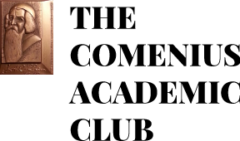Not so long ago, a small group of Czech and American scientists met in New York City and discussed the ways and means through which scientific institutions and universities on both sides of the Atlantic are supported. It was a productive meeting, which led to the idea to establish an independent cultural organization whose aim would be to engage in advocacy in some areas of general interest. Such an organization would bring together scientists and artists, as well as personalities from public life, to address matters of science, education, healthcare, economics, and culture. This marked the beginning of the Comenius Academic Club, the sponsor of this journal.
The first conference of the Comenius Academic Club took place in June 2013 in New York City. The program included a mini-symposium on Jan Amos Komenský (Comenius) and a session on the evaluation and funding of science in the United States and some European countries. The meeting was also used as a venue for the opening of the exhibition “Millennial Heritage of Czech Currency.”
The conference generated a genuine interest on both sides of the Atlantic. Shortly thereafter, the decision was made to establish a multidisciplinary, peer-reviewed journal devoted to Euro-American civilization. The journal should address both current issues as well as history, which could contribute to a better understanding of the present.
It is a privilege and a great honor for me to introduce the first issue of “Comenius: Journal of Euro-American Civilization.” The editors hope that the journal, which will come out biannually, will not only inform of our similarities and differences, but also that it will contribute to the selection of better options.
In this issue, you will find the content arranged in three sections. Since this is the introductory issue, the first part is devoted to the life and work of the world-famous Czech philosopher, thinker, and educator, Jan Amos Komenský (Comenius), whose name we have borrowed. Jaroslav Pánek of the Czech Academy of Sciences summarizes the legacy of Comenius for humankind. Petr Vorel of the University of Pardubice sheds light on and documents the use of images of Comenius on Czechoslovak and Czech banknotes and Eva Semotanová of the Czech Academy of Sciences leads us into the Comenian world of European geography.
The second part reflects in part the discussion of the evaluation and funding of science at the 2013 Comenius conference. Jiří Málek of the Czech government’s Committee on Research, Development, and Innovation introduces the new system of scientific evaluation in the Czech Republic. Slavoj Czesaný of the Economics University in Prague compares research funding and performance in the Czech Republic with that of other European countries. Juraj Iványi of Kings College London briefly introduces the methodology used by funding bodies in the United Kingdom and John Lehman of East Carolina University, together with Michael Prystowsky of the Albert Einstein College of Medicine describes the evaluation process of biomedical research in the United States.
In the final section of the journal, you will find reviews of three recently published books dealing with civilizational issues that cut across disciplinary boundaries.
It is my hope that you will find this volume informative as well as thought-provoking.
Francis D. Raška Editor
